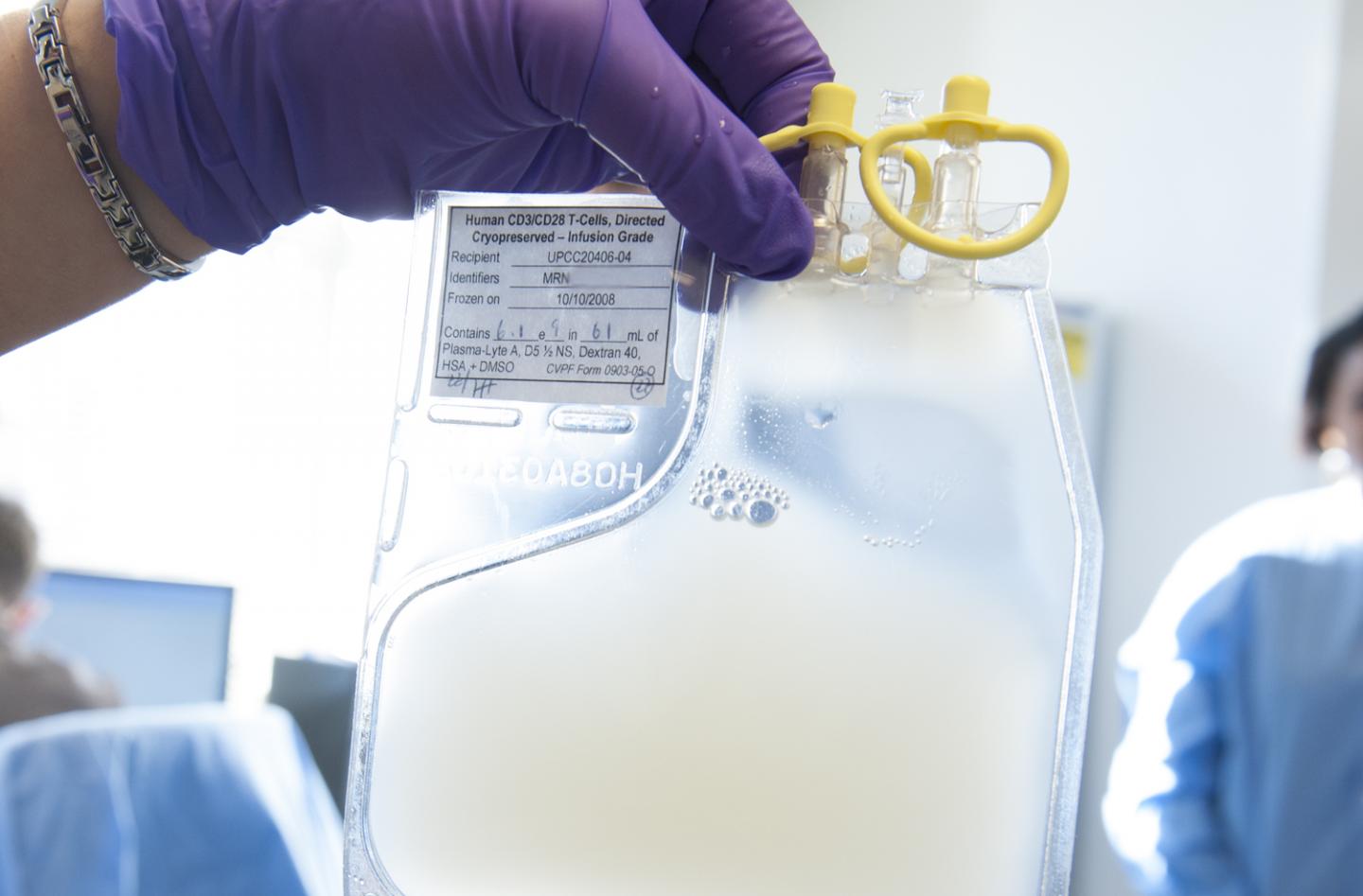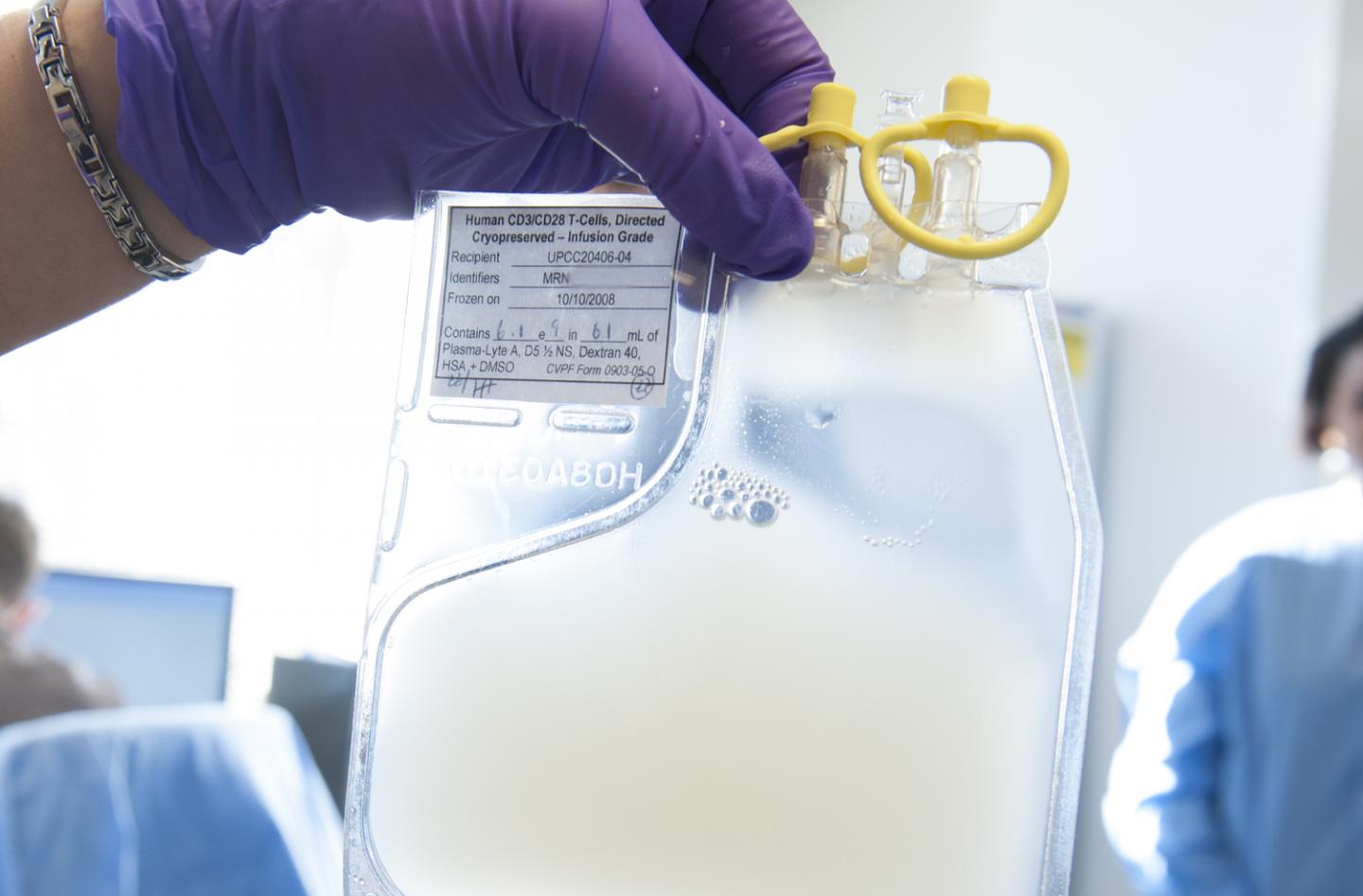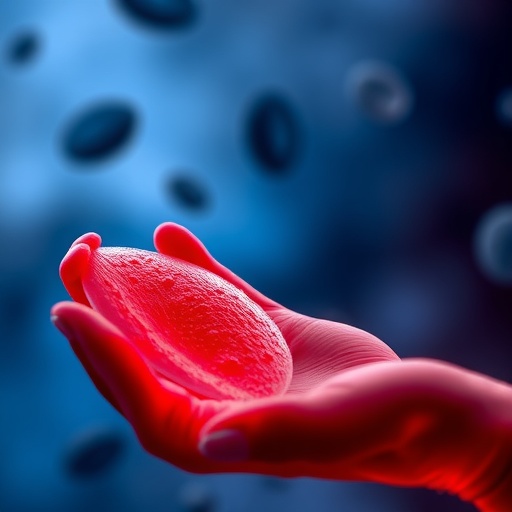
Credit: Penn Medicine
PHILADELPHIA – Penn Medicine researchers may have found the reason why some patients with advanced chronic lymphocytic leukemia (CLL) don't respond to chimeric antigen receptor (CAR) T cell therapy, and the answer is tied to how primed patients' immune systems are before the therapy is administered. While 80 percent of patients with advanced acute lymphoblastic leukemia (ALL) treated with the CAR T cell therapy now known as Kymriah™ have a dramatic response, only 26 percent of CLL patients respond to it in clinical trials. A new study from the Abramson Cancer Center of the University of Pennsylvania, published today in Nature Medicine, shows that CLL patients possessing a subset of vital, healthier T cells prior to CAR T cell therapy had a partial or complete clinical response to the treatment, while those lacking enough of those T cells did not respond. These healthier "early memory" T cells were marked by the expression of CD8 and CD27, as well as the absence of CD45RO. The findings show the potential to improve responses by enhancing a patient's immune cells with emerging cell manufacturing techniques before CAR T cell therapy.
What's more, the team – which was led by senior author J. Joseph Melenhorst, PhD and first author Joseph A. Fraietta, PhD, both faculty in the department of Pathology and Laboratory Medicine in Penn's Perelman School of Medicine and of Penn's Center for Cellular Immunotherapies, and included a multidisciplinary team from Penn and Novartis – also validated this signature in a separate, small group of patients and predicted with 100 percent accuracy who would experience complete remission.
"With a very robust biomarker like this, we can take a blood sample, measure the frequency of this T cell population, and decide with a degree of confidence whether we can apply this therapy and know the patient would have a response," Fraietta said. "The ability to select patients most likely to respond would have tremendous clinical impact, as this therapy would be applied only to patients most likely to benefit, allowing patients unlikely to respond to pursue other options."
The new findings point to a new T cell biomarker as a much-needed patient-selection tool, but they also present an opportunity to potentially improve the immunological health of a patient with emerging cell manufacturing techniques before CAR T cell therapy, as well as inform the design of a more effective CAR T cell.
In this new study, the researchers retrospectively studied 41 patients with advanced, heavily pre-treated and high-risk CLL who received at least one dose of CD19-directed CAR T cells. Consistent with the team's previously reported findings, they were not able to identify patient or disease-specific factors that predict who responds best to the therapy, including age, tumor burden, or prior therapies.
In several experiments, the team compared the gene expression profiles and phenotypes of T cells in patients who had complete, partial, or no response to the therapy. The analyses showed that the CAR T cells that persisted and expanded in complete responders were enriched in genes that regulate early memory and effector T cells and possess the IL-6/STAT3 signature, while non-responders expressed genes involved in late T cell differentiation, glycolysis, exhaustion, and apoptosis. These characteristics make for a weaker set of T cells to persist, expand, and fight the cancer.
"Pre-existing T cell qualities have previously been associated with poor clinical response to cancer therapy, as well differentiation in the T cells," Fraietta said. "What is special about what we have done here is finding that critical cell subset and signature."
Elevated levels of the IL-6/STAT3 signaling pathway – shown to enable T cell persistence in past studies – in these early T cells correlated with the clinical responses in patients from the CAR T cell therapy, the authors reported.
To validate the biomarker findings, the researchers screened for the early memory T cells in a group of eight CLL patients, before and after CAR T cell therapy. They identified the complete responders with 100 percent specificity and sensitivity.
Why some patients' T cells are suboptimal prior to treatment compared to others remains unclear, but it may have to do with their prior therapies, the authors said.
The findings also underscore the potential utility of increasing the therapeutic efficacy of T cells for CAR T cell therapy by selecting the subpopulation of T cells responsible for driving responses for cell manufacturing. However, it won't happen without overcoming some challenges first, the authors said.
"What we've seen in these non-responders is that the frequency of these T cells is low, so it would be very hard to infuse them as starting populations," Melenhorst said. "But one way to potentially boost their efficacy is by adding checkpoint inhibitors with the therapy to block the negative regulation prior to CAR T cell therapy, which a past, separate study has shown can help elicit responses in these patients."
Also unknown is the dosage of this T cell subset that would be required to turn non-responders into responders, he added. Future, clinical studies with a larger group of CLL patients should be conducted to help answer these questions and validate the findings from the study, the authors said.
"It will also be important to test if this biomarker approach to CAR T cell therapy can be extended to other cancer types, particularly solid tumors," Melenhorst said.
The team also includes Carl June, MD, the Richard W. Vague Professor in Immunotherapy in the department of Pathology and Laboratory Medicine and director of the Center for Cellular Immunotherapies, and David Porter, MD, the Jodi Fisher Horowitz Professor in Leukemia Care Excellence and director of Blood and Marrow Transplantation in the ACC, and researchers from Novartis.
In 2012, Penn and Novartis entered into a global collaboration to further research, develop and commercialize Kymriah, formerly known as CTL019, and other CAR-T cell therapies for the treatment of cancers. The therapy modifies patients' own immune T cells, which are collected and reprogrammed to potentially seek and destroy the patients' leukemia cells. After being infused back into patients' bodies, these newly built cells both multiply and attack, targeting cells that express a protein called CD19.
In August 2017, the U.S. Food and Drug Administration approved the Penn-developed therapy for the treatment of patients up to 25 years of age with B-cell precursor ALL that is refractory or relapsed.
###
This work was supported by funding from National Cancer Institute (T32CA009140, R01CA165206 and P01CA214278), a Stand Up to Cancer Phillip A. Sharp Innovation in Collaboration Award, and Novartis.
Editor's note: The University of Pennsylvania has licensed technologies involved in these trials to Novartis. Some of the scientists involved in these trials are inventors of these technologies. As a result of the licensing relationship with Novartis, the University of Pennsylvania receives significant financial benefit, and these inventers have benefitted financially and/or may benefit financially in the future.
Penn Medicine is one of the world's leading academic medical centers, dedicated to the related missions of medical education, biomedical research, and excellence in patient care. Penn Medicine consists of the Raymond and Ruth Perelman School of Medicine at the University of Pennsylvania (founded in 1765 as the nation's first medical school) and the University of Pennsylvania Health System, which together form a $7.8 billion enterprise.
The Perelman School of Medicine has been ranked among the top medical schools in the United States for more than 20 years, according to U.S. News & World Report's survey of research-oriented medical schools. The School is consistently among the nation's top recipients of funding from the National Institutes of Health, with $405 million awarded in the 2017 fiscal year.
The University of Pennsylvania Health System's patient care facilities include: The Hospital of the University of Pennsylvania and Penn Presbyterian Medical Center — which are recognized as one of the nation's top "Honor Roll" hospitals by U.S. News & World Report — Chester County Hospital; Lancaster General Health; Penn Medicine Princeton Health; Penn Wissahickon Hospice; and Pennsylvania Hospital — the nation's first hospital, founded in 1751. Additional affiliated inpatient care facilities and services throughout the Philadelphia region include Good Shepherd Penn Partners, a partnership between Good Shepherd Rehabilitation Network and Penn Medicine, and Princeton House Behavioral Health, a leading provider of highly skilled and compassionate behavioral healthcare.
Penn Medicine is committed to improving lives and health through a variety of community-based programs and activities. In fiscal year 2017, Penn Medicine provided more than $500 million to benefit our community.
Media Contact
John Infanti
[email protected]
215-301-5221
@PennMedNews
http://www.uphs.upenn.edu/news/
Related Journal Article
http://dx.doi.org/10.1038/s41591-018-0010-1





